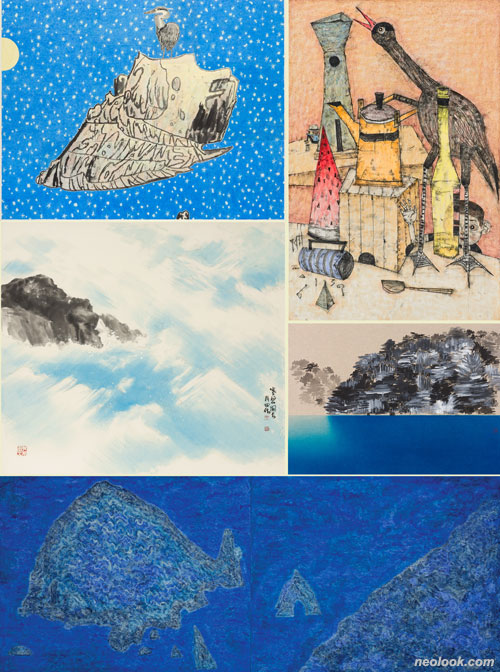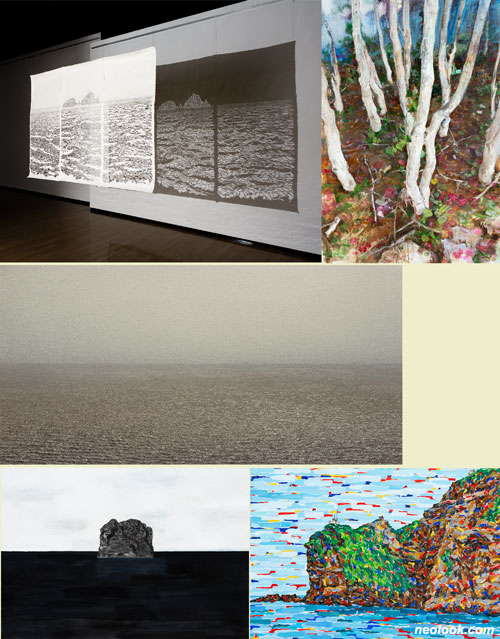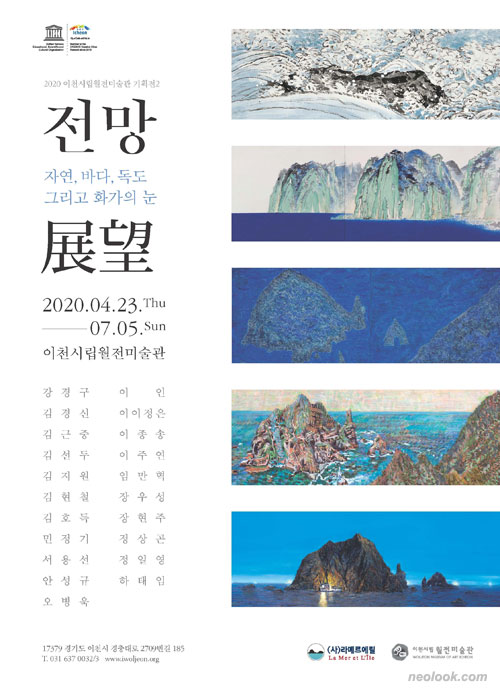- ● homepage
- ● archives
- ● restoration
- ● books
- ● big banners
- ● post board
- ■ neo's search
- ■ about us
- ■ 게재방법 안내
- 개인정보처리방침

- [email protected]
- Tel. 02_335_7922
- Fax. 02_335_7929
- 10:00am~04:30pm
- 월요일~금요일
- 3/3(월) 대체공휴일

전망展望: 자연을 바라보는 화가의 눈 Prospect: Nature, Sea, Dokdo and Eyes of Artist
2020년 기획展 2 2020_0423 ▶ 2020_0726 / 월요일 휴관
별도의 초대일시가 없습니다.
참여작가 강경구_김경신_김근중_김선두_김지원_김현철_김호득 민정기_서용선_안성규_오병욱_이인_이이정은_이종송 이주연_임만혁_장우성_장현주_정상곤_정일영_하태임
이천시립월전미술관 전시를 온라인으로 즐겨보세요. ▶ 이천시립월전미술관 유튜브 채널
기획 / 이천시립월전미술관_(사)라메르에릴
관람료 / 성인 2,000원
관람시간 / 10:00am~06:00pm / 월요일 휴관 코로나19 확산방지를 위해 5월19일부터 사전예약제로 운영합니다. 자세한 내용은 미술관 홈페이지(www.iwoljeon.org)를 참고해주시기 바랍니다.
이천시립월전미술관 WOLJEON MUSEUM OF ART ICHEON 경기도 이천시 경충대로2709번길 185 Tel. +82.(0)31.637.0033 www.iwoljeon.org
현대를 살아가는 우리에게 있어서 자연을 화폭에 담은 산수화 혹은 풍경화가 지니는 의미는 무엇일까. 우리나라의 경우 조선시대까지 수많은 산수화가 그려지면서 감상과 수장收藏의 대상이 되었지만 20세기가 되면서 그러한 모습은 급격히 사라졌다. 과거의 산수화는 단순히 눈에 보이는 풍경을 그린 것이 아니라 우주와 자연의 본질을 화폭에 압축한 것이었고, 화가와 감상자 모두 그림을 그리고 보면서 그 진리를 깨닫고 스스로를 수양, 성찰하는 의미를 지니고 있었다. 시간이 흐르면서 점차 그림 자체의 시각적인 부분에 무게를 두기도 했지만 그 기반은 변함이 없었다. ● 그러나 20세기 이래의 서구적인 근대화, 현대화로 인해 사회 전반이 문명화, 산업화, 도시화를 겪으며 크게 변화했고 자연스레 일상에서 산수화의 입지도 급격히 축소되었다. 산수가, 혹은 자연이 우주적 원리를 담고 있다는 과거의 생각 자체가 사라졌고, 자연스럽게 그 재현물이자 축소판으로 여겨졌던 산수화의 의미도 작아진 것이다. 그럼에도 불구하고 산수화와 그 제재가 되는 자연은 여전히 미술에 있어서 중요한 화두話頭로서, 작가들에게 중요한 창작의 영감을 제공하고 있다. 이는 자연이, 산수가 혹은 풍경이 무궁무진한 변화와 아름다움의 담지체擔持體라는 보편적인 사실 때문일 것이다.

- 김선두_그 섬에 가고싶다 / 임만혁_바다풍경13-8 장우성_조음 / 김현철_섬 이종송_Mountain in Motion-Concerto
현대의 작가들은 창작의 원천인 자연을 과거와 달리 보다 개별적인 차원에서 각자의 눈으로 또 각자의 표현방식으로 그려내면서 우리 시대 미술의 폭을 그 어느 때보다도 넓히고 있다. ≪전망: 자연, 바다, 독도 그리고 화가의 눈≫展은 자연을 제재로 한 현대 작가 21인의 작품을 통해 그 의미와 표현방식의 다양성 그리고 아름다움을 살펴보려는 의도로 마련되었다. 이번 전시에서는 자연 가운데에서도 특히 바다와 독도가 초점이다. 또한 오늘날 화가들이 이를 어떻게 바라보고 어떻게 표현하였는지에 주목했다. ● 과거의 산수화 혹은 풍경화에서 바다는 산이나 들에 비해서 적극적으로 다루어지던 대상이 아니었다. 동아시아의 산수화에서는 항상 산이 핵심적인 표현의 대상이었으며, 서양의 풍경화에서도 산이나 들이 주된 제재였다. 이처럼 바다가 활발히 그려지지 않았던 것은 해상 교통수단이 충분히 발달하지 않았던 시대적 상황에서 바다 자체로의 접근이 매우 제한적이었기 때문이다. 바다를 제재로 한 그림이 크게 증가하는 것은 19세기 서양의 기술 혁신과 무관하지 않다. 1807년 미국의 공학자 로버트 풀턴Robert Fulton(1765-1815)이 증기선蒸氣船을 상업용으로 개발했고, 이것이 점차 상용화되어 1838년에는 대서양을 횡단하기에 이르렀다. 19세기 들어 바다로의 접근성이 매우 커진 것이다.

- 김호득_독도-저녁 / 김지원_독도-화가의 비행 안성규_경계Border 20-51 / 서용선_독도-동도에서본 서도 민정기_우리섬 독도
해로海路를 이용한 장거리 이동과 여행이 보편화되면서, 화가들에게 바다도 더 이상 낯설지 않은 제재가 되었으며, 점차 풍경화의 제재로 자리 잡아가게 되었다. 러시아의 이반 아이바조프스키Ivan Aivazovsky(1817-1900), 미국의 윈슬로 호머Winslow Homer(1836-1910)처럼 해양화海洋畵로 명성을 얻은 화가가 19세기에 등장한 것도 이러한 배경에서였다(도1). 물론 독일의 화가 루돌프 바쿠이젠Ludolf Bakhuizen(1630-1708)처럼 17세기에 바다를 그린 이른 사례가 있긴 하지만 이는 예외적인 것이다. 동아시아에서 바다가 제재로 다루어진 것은 바로 이러한 서양의 영향을 통해서였다. 한국의 경우에도 서양의 영향이 강해지는 20세기 들어서 바다, 해변, 포구, 선박 등 바다 혹은 관련 제재의 그림이 등장하기 시작했다. 오늘날 화가들이 바다를 제재의 하나로 다루게 된 데에는 이러한 역사가 자리 잡고 있다. ● 그렇지만 바다를 그리는 것이 꼭 서양의 영향에 따른 것만은 아니다. 동아시아의 경우에도 17세기 이래 실제 경치를 제재로 한 실경산수화實景山水畵의 전통이 있었기 때문이다. 한국의 경우 조선 후기부터 현실을 중요시하는 사상이자 학문인 실학實學의 부상, 시민계급의 성장과 경제의 발달을 기반으로 한 여행의 붐, 이에 따른 기행문학의 유행, 명승지의 풍경을 담은 중국 명대明代 산수판화집의 전래 등이 맞물리며 감상적 회화, 예술적 회화로서 실경산수화의 입지가 커졌었다. 잘 알려져 있다시피 정선鄭敾(1676-1759)은 중국과 한국의 규범이 되는 화풍을 섭렵한 상태에서 실경과의 교감을 통해 사실성과 표현성이 조화된 독자적 산수화풍을 만들어냈고 실경산수화의 부상을 이끌었다(도2). 이는 전통, 사실에 기반하여 현대성과 표현성을 획득하고자하는 오늘날 작가들의 창작 태도에도 일정한 영향을 미치고 있다.

- 김경신_너울너울 / 정상곤_봄의 횡단 오병욱_Islands of my mind#202003042 이인_바다와 섬 Black, something / 정일영_독도
한편 작품의 제재로서의 독도獨島는 바다를 다룬 다른 어떤 그림보다도 우리에게 의미심장하다. 우리나라의 어느 곳이나 그 자체로서, 또 회화의 제재로서 소중하지만, 독도의 경우 삼국시대 이래 명확한 우리의 영토이면서도, 일본의 일방적이고 근거 없는 주장에 따라 이른바 '영유권 분쟁'의 대상이 되고 있기 때문이다. 이로 인해 독도는 우리에게 한국의 정체성을 상징하는 섬이 되었다. 오늘날 독도를 제재로 한 작품들은 모두 이러한 의미, 즉 우리의 영토로서의 독도에 대한 애정이 깔려있다. 19세기까지의 독도 이미지는 「울릉도지도鬱陵島地圖」(도3)에서 볼 수 있듯이 회화성이 배제된 지도형식으로만 존재했었기에, 독도를 제재로 한 현대의 작업들은 더욱 각별한 의미를 지닌다. 각 작가들이 자신만의 예술적 표현으로 독도를 아름답게 빚어내고자 한 의지의 산물이기 때문이다. 즉 오늘날 미술에 있어서 바다와 독도는 전통과 현대, 동양과 서양, 정체성과 보편성이 교차하고 융합하는 중요한 제재인 셈이다. ● 바다는 어떤 제재보다 확 트인 화면, 역동적인 표현으로 감상자를 압도한다. 때로는 다양한 색채를 띤 파도가 밀려오고, 때로는 거친 폭풍우 속에서 강한 생명력을 드러내기도 하며 때로는 고요하기 그지없는 침묵의 모습을 보여주기도 한다. ≪전망: 자연, 바다, 독도 그리고 화가의 눈≫展의 21인의 작가는 바다와 혹은 자연과 대화하며 시시각각 다른 모습으로 변화하는 그 모습을 예민한 붓끝으로 포착하여 화폭 안으로 옮겨냈다. 우리는 여기에서 오늘날 한국 미술의 과거와 현재 그리고 미래를 본다. ■ 장준구

- 이주연_Echo Beyond time in two pieces / 하태임_섬,LÎle 장현주_물결은 바람에 흔들리고 / 김근중_밤.독도-1 이이정은_거기, 바다와 섬_202007 / 강경구_떠 있는 섬2
For us living in modern times, what is the meaning of landscape paintings or landscapes that contain nature in canvas? In the case of Korea, numerous landscape paintings were painted until the Joseon Dynasty, becoming the subject of appreciation and collecting, but such images quickly disappeared in the 20th century. In the past, landscape paintings were not just paintings of visible landscapes, but compressing the essence of space and nature on canvas, and both painters and viewers had the meaning of realizing the truth and cultivating and reflecting themselves. Over time, they gradually put more weight on the visual part of the painting itself, but the foundation remained unchanged. ● However, Western modernization since the 20th century led to a significant change in society as a whole through civilization, industrialization, and urbanization, and naturally, the position of landscape painting in everyday life was drastically reduced. The past idea that arithmetic, or nature, contains cosmic principles, has disappeared, and naturally the meaning of landscape painting, which was considered a reproduction and miniature version, has also been reduced. Nevertheless, landscape painting and its sanctioned nature are still an important topic in art, providing important creative inspiration for artists. This may be due to the universal fact that nature, arithmetic, is the essence of endless change and beauty. ● Modern artists are expanding the scope of art in our times more than ever, drawing nature, a source of creativity, with their own eyes and methods of expression on a more individual level, unlike in the past. The exhibition was designed to examine the meaning, diversity and beauty of the way of expression through the works of 21 contemporary artists who sanctioned nature. This is particularly sea and Dokdo is the centrepiece. It also noted how today's painters looked at it and expressed it. ● In the past, in eastern landscape painting or western landscape painting, the sea was not an active target compared to the mountains and fields. In the landscape paintings of East Asia, mountains have always been the key subject of expression, and in Western landscape paintings, mountains and streams have also been the main sanctions. The reason why the sea was not so active was because access to the sea itself was very limited in times when sea transportation was not fully developed. The large increase in the picture of the sea with sanctions has nothing to do with the technological innovation of the 19th century in the West. In 1807, American engineer Robert Fulton developed steamboats for commercial use, which gradually became commercialized and led to the crossing of the Atlantic Ocean in 1838. In the 19th century, access to the sea has grown very large. ● As long-distance travel and travel using sea routes became common, the sea became no longer an unfamiliar sanction for painters, and gradually became a sanction for landscape painting. It was against this backdrop that painters such as Ivan Ivazovski of Russia(1817-1900) and Winslow Homer(1836-1910) of the United States emerged in the 19th century. Of course, there were early examples of sea paintings in the 17th century, such as German painter Ludolf Bakhuizen(1630-1708), but this was exceptional. It was through these Western influences that the sea was treated as sanctions in East Asia. In the case of Korea, paintings of the sea or related sanctions, such as sea, beaches, ports, ships, etc., began to appear in the 20th century when Western influence became stronger. This history holds true for painters today to treat the sea as one of the sanctions. ● However, painting the sea is not necessarily made up of Western influences alone. This is because East Asia has had a tradition of real scenery landscape painting since the 17th century. In the case of Korea, the rise of Silhak, an ideology and academic discipline that values reality from the late Joseon Dynasty, the boom of travel based on the growth of the citizen class and economic development, the trend of travel literature, and the tradition of a famous landscape print house in China, which contains the scenery of famous places, have combined to increase its position as an emotional painting and an artistic painting. As is well known, Jeong Seon鄭敾(1676-1759) developed an independent landscape painting style that harmonizes reality and expression through communication with the real world and led to the rise of the real scenery landscape painting. This also has a certain influence on the creative attitudes of today's artists who want to achieve modernity and expressiveness based on tradition and facts. ● Meanwhile, Dokdo is historically more meaningful than the sea to us. Dokdo is our territory from the Three Kingdoms Period were clear. However, Japan has continued to make groundless and unilateral claims. This is because it caused a territorial dispute. As a result, to Dokdo is our symbol of the nation's identity. Today, Dokdo as our territory, or a Dokdo as a sanction means these works are all with affection for. In addition, each author, beautifully by the Dokdo as their own artistic expression to the product of a will. As can be Dokdo in the Ulleung Island map(鬱陵島地圖) images to the 19th century painting is excluded Dokdo as a sanction, had only then that the type of a modern map. Work are more particular meaning. In other words and Dokdo are traditional and modern art in the ocean today, East and West, the identity and universality to converge and intersect sanctions. ● The sea overwhelms the viewer with a more open screen and dynamic expression than any other sanction. Sometimes waves come in various colors, sometimes revealing strong vitality in harsh storms, and sometimes showing a still silence. Twenty-one artists presented in this exhibition captured the changing appearance of the sea or nature with sensitive brush tips and moved it into the canvas. Here we see the past, present and future of Korean art today. ■ Chang Junegu
Vol.20200423c | 전망展望: 자연을 바라보는 화가의 눈展

